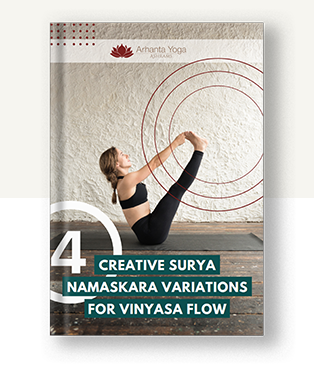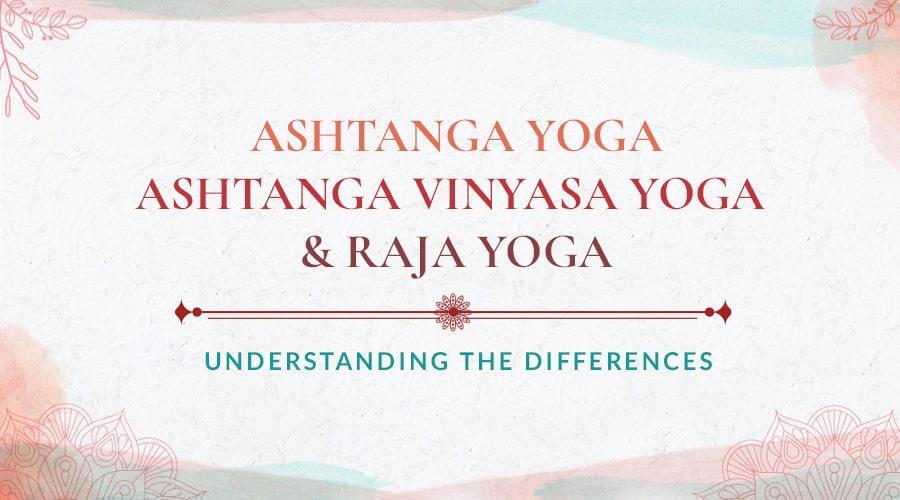The Two Meanings of Ashtanga
Ashtanga translates literally to mean “eight limbs”. The word is a combination of two Sanskrit words: “ashta” meaning eight, and “anga” meaning limb. In modern use, Ashtanga has two distinct meanings: it’s a name for an ancient philosophy of yoga, and also a modern series of choreographed asana practices.
When Ashtanga means 8 limbs
Ashtanga as first used around 2500 years ago by Maharishi Patanjali in his book Raja Yoga Sutras, has been used for generations to refer to the Yoga philosophy of practicing eight parts or limbs of yoga in order to reach enlightenment. Raja Yoga, the path of yoga that involves practicing these eight limbs, is therefore also called Ashtanga Yoga.
There are three other paths of yoga – action, devotion and knowledge – that don’t involve eight limbs or any physical asana practice. You can learn more about these in The Four Paths of Yoga.
You may be wondering where Hatha Yoga fits in this complicated name system. Hatha was originally called Shatanga, which translates as ‘six limbs’. Ashtanga came first, and then two of the limbs were excluded to form a new approach to yoga practice. Hatha Yoga is simply Ashtanga (or Raja) Yoga without the limbs known as Yama and Niyama.
The modern Western practice of yoga typically includes the physical practice of asana, often with the addition of breathing exercises and meditation. These are three of the limbs of Hatha Yoga, which in turn was born from the eight-limbed original Ashtanga or Raja Yoga.
When Ashtanga means 6 specific sequences
Pattabhi Jois (1915-2009) was an influential yoga teacher who adopted the name Ashtanga for his sequences. He chose the word ashtanga because he intended to create eight sequences for complete control of body and mind. He only created six – by that stage, the sequences were so difficult hardly anyone could practice them as intended.
Jois’s Ashtanga is not so much a yoga style as it is a set of choreographed sequences of asana. There is no variability or freedom to adapt in a yoga practice using Jois’s Ashtanga. The yoga student is expected to copy the movements and poses exactly how Jois performed them.
Some time later, Jois also began using the phrase ‘Ashtanga Vinyasa Yoga’. He was still referring to his six specific sequences, adding the term ‘vinyasa’ in reference to the movements flowing from pose to pose.
The Meaning of Vinyasa
Sri Krishnamacharya (1888-1989) is considered the father of Vinyasa Yoga as a style of yoga practice. He taught that the movements between each asana should be considered just as significant as the postures themselves.
Many claim ‘vinyasa’ means ‘with the breath’. Although breath is used as an important component in Vinyasa Yoga, 'vinyasa' does not mean breath.
Defining vinyasa:
- ‘vi’ means ‘specially’
- ‘nyasa’ can mean ‘to place’, ‘special order’, or ‘attention’
Vinyasa therefore has multiple meanings in Sanskrit.
When used in reference to yoga, it should be interpreted as ‘special way’, or ‘special order’, or ‘with attention’. It means, as Krishnamacharya taught, that special attention is paid to the whole process, not just the pose itself.
To better understand what vinyasa means, you might need to step back and consider what is not vinyasa. Traditional practice of asana, as in a Hatha Yoga class, involves discrete postures. The focus is on holding a pose while breathing evenly and attempting to achieve calm and comfort while in the pose. The heart rate is meant to stay at a resting level. The transition between poses, and the focus of attention during the transition, is not considered important.
In Vinyasa Yoga, the transition between poses is much more important. Attention is kept on the body and the movement. Using the breath in time with the movement is a way of guiding attention and focus throughout the flow of movement.

Get a free copy of our illustrated e-book 4 Surya Namaskara Variations for Vinyasa Yoga
Modern Vinyasa Flow Yoga
Modern classes called Vinyasa or Flow - or even Vinyasa Flow – may use components from Jois’s Ashtanga sequences, but they are much freer. It’s common for a Flow class to follow a similar structure to an Ashtanga sequence - beginning with Sun Salutations and continuing with standing sequences that probably featured in Jois’s first, second or third series.
In a Flow class, the teacher is free to explore a wide range of asana. Defining the class as Vinyasa Yoga doesn’t necessarily mean it will be easier or harder than other styles. A vinyasa class might be designed for beginners or advanced practitioners, or intended to cater to all levels. It’s entirely up to the intentions and experience of the teacher.
Getting a workout in a yoga class is a popular modern goal and a distinct difference between the classes of traditional Hatha Yoga and Vinyasa Yoga.
- Hatha, performed at a resting heart rate, is intended to stimulate the lymphatic, endocrine and other internal systems to improve health.
- Vinyasa, being more movement-intensive, provides more of a cardiovascular challenge.
How taxing a Vinyasa Yoga 'workout’ feels is up to the teacher and the student.
Key Differences Between Ashtanga Yoga and Ashtanga Vinyasa Yoga
The differences between Ashtanga Yoga, Ashtanga Vinyasa and Raja Yoga are not that complicated if you accept that some words have had different uses over time.
Ashtanga, and also Raja Yoga, refer to the ancient yoga philosophy of achieving enlightenment by practicing the eight limbs of yoga - but if you go to a yoga studio and join an Ashtanga Yoga class, you will be performing a very specific pose sequence designed in the 1900s by Patthabi Jois.
Vinyasa, a concept taught by Krishnamacharya from the early 1900s, suggests that the movements between poses should be considered as important as the poses themselves. This concept was applied by Jois in his choreographed sequences; hence those sequences are referred to as Ashtanga Vinyasa Yoga.
Ashtanga Vinyasa Yoga inspires modern Vinyasa Flow Yoga, but Ashtanga Vinyasa is limited to Jois’s series of six sequences. Modern Vinyasa Yoga classes feature asana sequences that change with every class. Many yoga practitioners, both teachers and students, enjoy the pace, freedom and adaptability of Vinyasa Flow Yoga.

